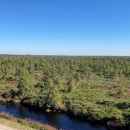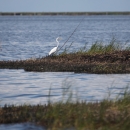States
MissouriNews
The U.S. Fish and Wildlife Service, the Missouri Department of Natural Resources and the U.S. Forest Service are seeking public input on two draft Restoration Plans for the Viburnum Trend and the Meramec Basin. These plans describe efforts to implement woodland and stream restoration on private and public lands in the Viburnum Trend, and to work with land owners in the Big River and Huzzah Creek drainages as part of a joint restoration effort with various non-governmental organizations and will to make additional leveraging funding available from the Natural Resource Conservation Service.
Comments may be submitted via writing or email to Leslie Lueckenhoff, (Leslie_Lueckenhoff@fws.gov; 101 Park DeVille Dr., Suite A., Columbia, Missouri 65203) using the name of draft restoration plan in the subject line. Comments must be received by December 7, 2023 to be considered. Please send comments for restoration plans in separate emails identifying the restoration plan you are commenting on (i.e., "Comments on Draft Restoration Plan - Viburnum Trend" OR "Comments on Draft Restoration Plan - RCPP").
- Draft Restoration Plan and Environmental Assessment for Terrestrial and Aquatic Habitat Restoration in the Viburnum Trend
- Natural Resource Restoration in the Meramec River Basin: Regional Conservation Partnership Program - Draft Restoration Plan and Environmental Assessment
Overview
Mining and smelting sites within St. Francois, Reynolds, Jefferson and Iron Counties in Missouri are located within the Southeast Missouri Lead Mining District, an area that was mined extensively for lead and zinc for more than a century. As a result of this mining and related activities, large amounts of metals including cadmium, lead, zinc, and nickel were released and are continuing to be released into Missouri's environment. Cadmium, lead, zinc, and other metals associated with mining are potentially toxic to a wide variety of plants and animals.
Trustees
Under the Comprehensive Environmental Response, Compensation and Liability Act, and implementing regulations, the Director of the Department of Natural Resources (Missouri DNR) and the U.S. Department of the Interior (DOI) are Trustees for natural resources in the Southeast Missouri Lead Mining District . Natural resources over which Missouri DNR and DOI exercise trusteeship include surface waters (rivers, lakes, streams, etc.), ground water, soils, air, plants, and animals. As Trustees, the State of Missouri and DOI serve as stewards for these resources within the Southeast Missouri Lead Mining District and have the authority to assess whether the resources and their services have been injured as a result of release(s) of hazardous substances. Injuries to natural resources can occur if the resources are exposed to concentrations of hazardous substances that are high enough to cause specific adverse effects. For example, injuries can occur if lead and/or zinc concentrations in surface waters are so high that relevant water quality criteria are exceeded. Plants and animals are injured if they die, cannot reproduce normally, become sick or are otherwise negatively affected as defined under relevant laws and regulations.
Natural Resource Damage Assessment and Restoration Process
The process through which the Trustees evaluate injuries to natural resources associated with the release(s) of hazardous substances and determine appropriate compensation for those injuries is called natural resource damage assessment and restoration (NRDAR). DOI promulgated and published NRDAR regulations in the Federal Register (43 CFR Part 11.). These regulations provide procedures by which trustees can identify natural resource injuries, quantify those injuries, determine appropriate compensation (damages) for the injured resources and the services they provide, and restore those injured resources. The NRDAR process includes a number of different steps, specifically:
- Pre-assessment
- Assessment planning
- Assessment
- Post-Assessment Planning and Implementation
DOI and the State of Missouri have begun a NRDAR for portions of the Southeast Missouri Lead Mining District. In June 2008, the Trustees completed the pre-assessment phase for the Big River Mine Tailings Superfund Site and Surrounding Area in the St. Francois County portion of Southeast Missouri Lead Mining District and three sites within the Viburnum Trend portion of the Lead Mining District: Sweetwater Mine and Mill Complex, West Fork Mine and Mill Complex, and Glover Smelter, which culminated in two Preassessment Screens and Determinations (Missouri DNR and DOI 2008). In the Preassessment Screens, in accordance with applicable regulations, the Trustees concluded that further investigation and assessment of natural resource injury and damages was warranted at the Sites described above. 43 C.F.R §§11.24 and 11.25.
Restoration
Restoration Plans and Projects
The Trustees have developed multiple Restoration Plans related to several settlements within Southeast Missouri. For each Restoration Plan, the Trustees evaluated a range of restoration actions and alternatives, which will restore, rehabilitate, replace and/or acquire the equivalent of those natural resources and their services that were injured. Descriptions of restoration projects to be implemented in Southeast Missouri or specific mining districts in Southeast Missouri include:
Viburnum Trend
| Project Name | Description |
|---|---|
| West Fork Black River Bottomland | The West Fork Black River Bottomland project will restore the hydrology of the West Fork Black River bottomland area to return the natural flow to springs and wetlands within the project area. The project will create and further support important aquatic and terrestrial habitats that including bottomland hardwoods, ephemeral wetlands, wet-meadows, and forested wetlands. |
| Native Plant Diversity Restoration | The Native Plant Diversity Restoration project focuses on the eradication and control of non-native invasive species invasive species An invasive species is any plant or animal that has spread or been introduced into a new area where they are, or could, cause harm to the environment, economy, or human, animal, or plant health. Their unwelcome presence can destroy ecosystems and cost millions of dollars. Learn more about invasive species across public lands on the Mark Twain National Forest. The project will restore or enhance habitats supportive of migratory birds and other terrestrial resources. |
| Wilderness Connection and Watershed Protection – East Fork Black River | Land with high quality natural resources was acquired and made available to the public as an addition to the Mark Twain National Forest. This project preserves and protects 1,104 acres in the headwaters of the East Fork of the Black River. |
| Crooked and Huzzah Creek Restoration | Restores and protects stream banks, riparian riparian Definition of riparian habitat or riparian areas. Learn more about riparian forests and floodplain habitat along Crooked Creek and Huzzah Creek. This project creates contiguous blocks of restored habitat that support migratory birds and improves water quality. |
| Doe Run Viburnum Trend Restoration | The Doe Run Viburnum Trend Restoration project is a collaborative restoration project between the Trustees and the Doe Run Company. This project protects and provides public access to 1,000 acres of land donated by Doe Run, restores up to 10 miles of contaminated streams, restores native vegetation to 1,240 acres of tailings impoundments and surrounding soils following their closure, and restores soils and native vegetation on up to 840 acres of land owned by the Doe Run Company. |
| Herculaneum Lead Smelter Site | This project protects and provides public access to 105 acres of land donated by the Doe Run Company along Joachim Creek. |
| Amendment – Herculaneum Lead Smelter Site | Administers a Conservation Easement and supports ecological monitoring and habitat restoration at the Herculaneum Lead Smelter Site along Joachim Creek. |
| Feral Hog Removal Project | Protects terrestrial and aquatic habitats and the species they support through the targeted reduction of feral hogs across portions of four counties in the Viburnum Trend. |
Administrative Record Index
Southeast Missouri Lead Mining Sites NRDAR Administrative Record Index
Additional Information
In addition to this website, you can learn more about the Southeast Missouri Lead Mining District NRDAR by visiting the Missouri Department of Natural Resources Southeast Missouri NRDAR website.





